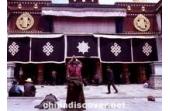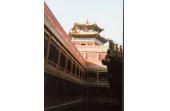Potala Palace
- Things to do
-
- Photo(13)
- Tips&article(58)
- Make it Happen
- Map
-
loading...
Special Attractions
 Ocean Park
Ocean Park
|
 Confucius Temple
Confucius Temple
|
 Bell Tower
Bell Tower
|
 Koguryo Historic Site
Koguryo Historic Site
|
 Inner Mongolian Museum
Inner Mongolian Museum
|
 Daqing
Daqing
|
 Tachuan
Tachuan
|
 Zhaoling Tomb
Zhaoling Tomb
|
Top 5 Lists
The world famous Potala Palace is located on Moburi (Red) Mountain, to the west of old Lhasa. It is a huge treasure house of materials and articles from Tibetan history, religion, culture and art. The palace is widely known for the precious sculptures, murals, scriptures, Buddha statues, murals, antiques, and religious jewelry housed within. They are of great cultural and artistic value. In 1994, the Potala Palace was declared a UNESCO World Cultural Heritage Site. It was originally built in the 7th century, during the reign of King Songtsan Gampo of Tibet.
The 13-story palace stands 117 meters high and has over 1,000 rooms. It covers an area of 130,000 square meters. The entire building is made of stone and wood, with walls averaging 3 meters thick.
The Red Palace contains various chapels and mausoleums of previous Dalai Lamas. The fifth Dalai Lama's mausoleum is in the west part of the palace and is five stories high. His enormous chorten, a mound-like structure containing the remnants of a Buddhist saint, is gold-covered and inlaid with diamonds, pearls, turquoise, agate and coral. The whole structure stands 14 meters high.
The White Palace contains the living quarters of successive Dalai Lamas and their tutors. The offices of the old Tibetan government and their assembly halls are also located here. The original Potala was destroyed in the ninth century, during the breakdown of the Tubo Kingship era. It was rebuilt during the reign of the fifth Dalai Lama and completed in the late seventeenth century. It had also became known as the "Winter Palace" by the 1750s, after the seventh Dalai Lama built the Norbulingka Park, as his summer residence.
The Potala is full of elaborate artwork and frescos that tell many stories. They portray religious subjects as well as the customs and traditions of Tibet. The frescos in the west hall depict the life story of the fifth Dalai Lama. One picture describes an important meeting between the fifth Dalai Lama and the Chinese Emperor Shun Zhi in 1652. It was after this meeting that the title Dalai Lama (Great Ocean) was bestowed on him and successive leaders of Tibet.
The Potala contains many other precious works of art, including ornately decorated statues, sculptures and Tibetan painting. The topmost hall in the Potala is called Sasong Langjie. It was built in 1679, and it contains a portrait of the Qing Emperor Qianlong bearing the words "A long, long life to the present emperor" written in Han, Manchu, Mongol and Tibetan. Dalai Lamas have come to pay homage to this portrait on each Tibetan New Year's Day for hundreds of years.
The Potala has been a sacred place for hundreds of years. Thousands of pilgrims from Tibet, other parts of China and abroad come every year to pay homage. Their devotion is shown by the difficult journeys they have to make to reach “the City of the Gods".
After the Chinese government resumed its administration over Tibet in 1950, Potala Palace was listed as a cultural relic under the special protection of the state. Architecturally, it is considered to be one of the wonders of the world, admired by the Chinese and people from around the world.
Related Readings
- Tibet Travel Tips
- Tibet Tour Packages
- Watch videos of Tibet
How to Get to there?
Tips & articles
|
|
|
forum discussion
|
|
|



